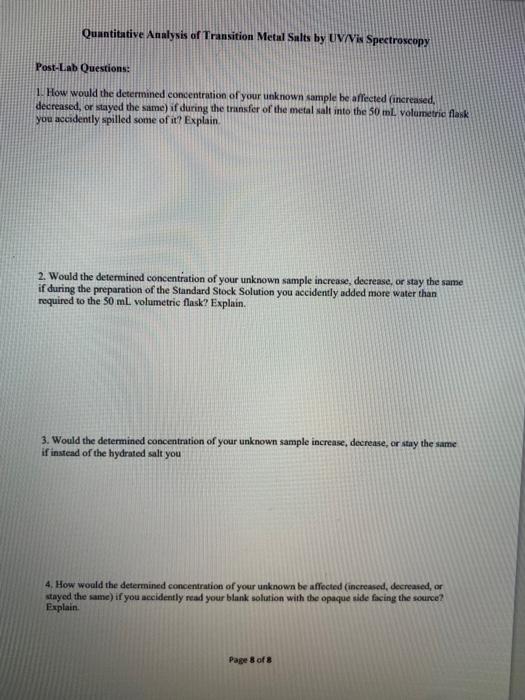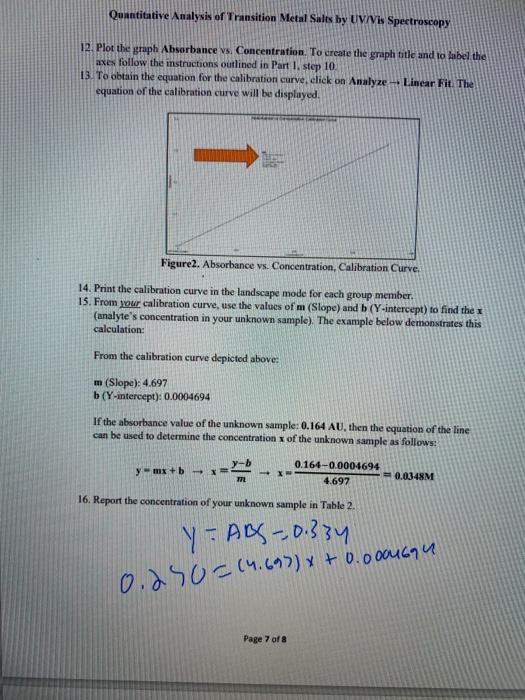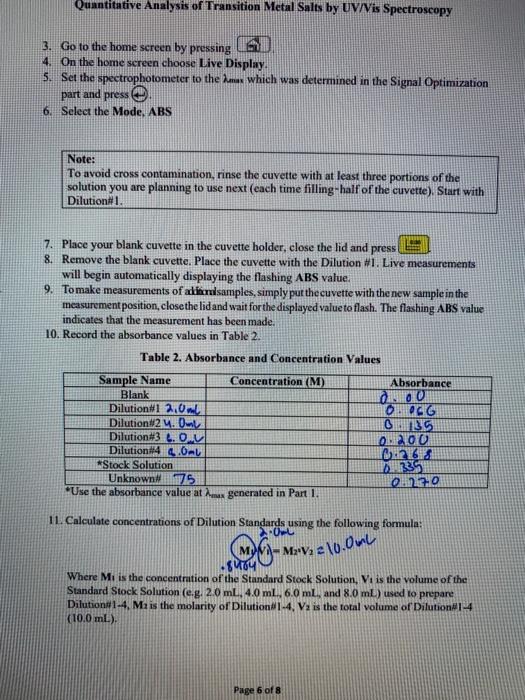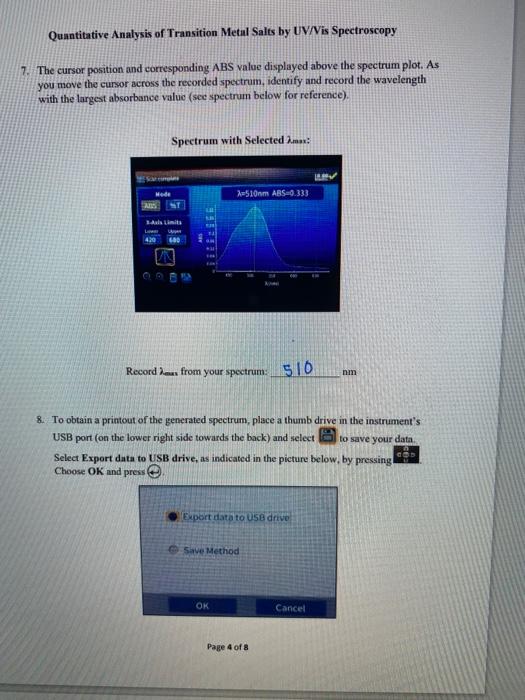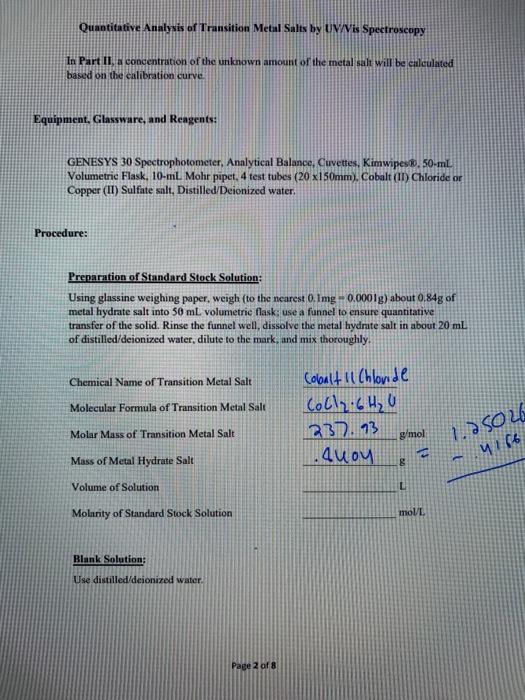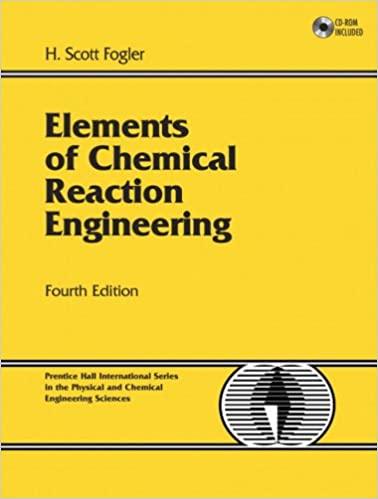Quantitative Analysis of Transition Metal Sults by UV/Vis Spectroscopy Post-Lab Questions: 1. How would the determined concentration of your unknown sample he affected (increased, decreased, or stayed the same) if during the transfer of the metal salt into the 50 mL volumetric flask you accidently spilled some of it? Explain 2. Would the determined concentration of your unknown sample increase, decrease, or stay the same if during the preparation of the Standard Stock Solution you accidently added more water than required to the 50 mL volumetric flask? Explain. 3. Would the determined concentration of your unknown sample increase, decrease, or stay the same if instead of the hydrated salt you 4. How would the determined concentration of your unknown be affected (increased decreased, or stayed the same) if you accidently read your blank solution with the opaque side facing the source? Explain Page 8 of 8 Quantitative Analysis of Transition Metal Salts by UV/Vis Spectroscopy 12. Plot the graph Absorbance vs. Concentration. To create the graph title and to label the axes follow the instructions outlined in Part I. step 10 13. To obtain the equation for the calibration curve, click on Analyze - Linear Fit. The equation of the calibration curve will be displayed Figure 2. Absorbance vs. Concentration, Calibration Curve. 14. Print the calibration curve in the landscape mode for each group member. 15. From your calibration curve, use the values of m (Slope) and b (Y-intercept) to find the I (analyte's concentration in your unknown sample). The example below demonstrates this calculation: From the calibration curve depicted above: m (Slope): 4.697 b (Y-intercept): 0.0004694 If the absorbance value of the unknown sample: 0.164 AU, then the equation of the line can be used to determine the concentration of the unknown sample as follows: 0.164-0.0004694 y-mx+ bX 4.697 = 0.0348M -X 16. Report the concentration of your unknown sample in Table 2. Y-ABS-0.334 0.25o = (4.697) x + 0.000469 Page 7 of 8 Quantitative Analysis of Transition Metal Salts by UV/Vis Spectroscopy 3. Go to the home screen by pressing 4. On the home screen choose Live Display. 5. Set the spectrophotometer to the hos which was determined in the Signal Optimization part and press @ 6. Select the Mode. ABS Note: To avoid cross contamination, rinse the cuvette with at least three portions of the solution you are planning to use next (each time filling-half of the cuvette). Start with Dilution#1. 7. Place your blank cuvette in the cuvette holder, close the lid and press 8. Remove the blank cuvette. Place the cuvette with the Dilution #1. Live measurements will begin automatically displaying the flashing ABS value. 9. Tomake measurements of admisamples, simply put the cuvette with the new sample in the measurement position, close the lid and wait for the displayed value to flash. The flashing ABS value indicates that the measurement has been made. 10. Record the absorbance values in Table 2 Table 2. Absorbance and Concentration Values Sample Name Concentration (M) Absorbance Blank 00 Dilution#1 2.0 OG Dilution2 M. Dal 35 Dilution#3 LOL OL200 Dilution#4 4.0 10:23 *Stock Solution 0335 Unknown 75 0:10 Use the absorbance value at generated in Part 1 11. Calculate concentrations of Dilution Standards using the following formula: -0 MrV, \o.Owl MONA- quoy Where Mi is the concentration of the Standard Stock Solution, Vi is the volume of the Standard Stock Solution (e.g. 20 mL, 4.0 mL, 60 ml, and 8.0 mL) used to prepare Dilution 1-4. Mi is the molarity of Dilution 1-4, V2 is the total volume of Dilution 4 (10.0 mL). Page 6 of 8 Quantitative Analysis of Transition Metal Salts by UV/Vis Spectroscopy 7. The cursor position and corresponding ABS value displayed above the spectrum plot. As you move the cursor across the recorded spectrum, identify and record the wavelength with the largest absorbance value (see spectrum below for reference). Spectrum with Selected 2=510nm ABS 0.333 Mode AD als Limits 420 600 Records from your spectrum: 510 8. To obtain a printout of the generated spectrum, place a thumb drive in the instrument's USB port (on the lower right side towards the back) and select to save your data Select Export data to USB drive, as indicated in the picture below, by pressing Choose OK and press @ COS Export data to USB drive Save Method OK Cancel Page 4 of 8 Quantitative Analysis of Transition Metal Salts by UV/Vis Spectroscopy In Part II, a concentration of the unknown amount of the metal salt will be calculated based on the calibration curve Equipment. Glassware, and Reagents: GENESYS 30 Spectrophotometer, Analytical Balance, Cuvettes. Kimwipes. 50-ml Volumetrie Flask, 10-ml Mohr pipet, 4 test tubes (20 x150mm). Cobalt(II) Chloride or Copper (II) Sulfate salt, Distilled/Deionized water. Procedure: Preparation of Standard Stock Solution: Using glassine weighing paper, weigh (to the nearest O. Img 0.0001g) about 0.84g of metal hydrate salt into 50 mL volumetrie flask: use a funnel to ensure quantitative transfer of the solid. Rinse the funnel well, dissolve the metal hydrate salt in about 20 ml of distilled/deionized water, dilute to the mark and mix thoroughly. Chemical Name of Transition Metal Salt Molecular Formula of Transition Metal Salt Cobalt ll Chlonde Colly 6HO 237.13 Molar Mass of Transition Metal Salt g'mol 1.asole 4166 1.4 Mass of Metal Hydrate Salt 8 Volume of Solution L Molarity of Standard Stock Solution moll Blank Solution: Use distilled/deionized water Page 2 of 8
